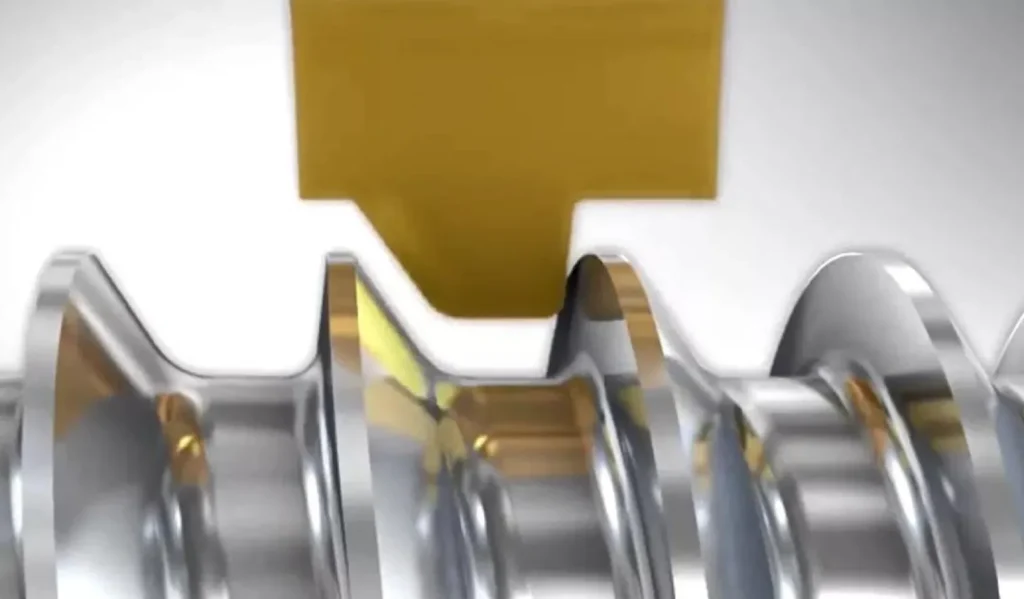先端交換式ドリル究極ガイド
精密加工の世界では、効率と精度が最も重要です。そこで 先端交換式ドリルこの革新的な設計は、ソリッドドリルの性能と刃先交換式チップの汎用性と費用対効果という両方の長所を兼ね備えています。この革新的な設計は、ソリッドドリルの性能と、刃先交換式チップの汎用性とコスト効率という、両方の長所を兼ね備えています。
マシニングセンター、CNC旋盤、穴あけ専用機のいずれであっても、穴あけ加工が機械加工で最も頻繁に行われる工程であることは広く受け入れられている。適切なドリルと加工工程を選択する際、重要な検討事項には、穴当たりのコスト、穴の品質、穴の完成度が含まれます。刃先交換式ドリルは、生産性、精度、経済性に優れた穴あけ加工オプションとして登場し、複数の材料や用途に柔軟に対応し、最適な性能を発揮します。
この包括的なガイドでは、刃先交換式ドリルの世界を掘り下げ、その特徴、利点、そして現代の加工工程に欠かせないものとなっているアプリケーションを探ります。

先端交換式ドリルについて
交換可能な先端ドリル交換可能な刃先ドリルまたはモジュール式ドリルとも呼ばれ、交換可能な刃先を持つように設計された切削工具である。従来のソリッドドリルとは異なり、この工具は、鋼製の本体に交換可能なカーバイドインサートを刃先に備えています。この設計により、ドリル本体全体を交換することなく、摩耗した刃先を迅速かつ容易に交換することができます。
先端交換式ドリルの主な構成部品は以下の通りである:
- ドリル本体:工具の主軸で、通常は高強度鋼でできている。
- インサートシート:切削インサートを保持するために工具先端に設けられた、精密に設計されたポケット。
- カッティング・インサート:実際の切削を行う取り外し可能な超硬チップ。
- クランプ機構:インサートを確実に固定するシステム
従来のソリッドドリルに対する先端交換式ドリルの利点は数多くある:
- 工具コストの削減:ドリル全体を交換するのではなく、チップのみを交換する必要があります。
- 生産性の向上:迅速なインサート交換でダウンタイムを削減
- 安定した性能:チップ交換毎に新しい切れ刃
- 柔軟性:1つのドリル本体で、様々な用途に応じた様々な形状のチップに対応可能
先端交換式ドリルの種類
交換可能な先端ドリルは、さまざまな加工ニーズに合わせてさまざまな構成があります:

シングルフルートのデザイン:
- 深穴加工に最適
- 難削材での優れた切屑排出性
- 多くの場合、航空宇宙および自動車用途で使用される
ダブルフルートのデザイン:
- バランスのとれた切削力で穴の品質を向上
- 幅広い素材と用途に対応
- 一般的な機械加工
マルチフルートのオプション:
- 安定した条件下での高速ドリリング用に設計
- 優れた穴仕上げと真直度を提供
- 大量生産環境でよく使用される
先端交換式ドリルの主な特長
切断形状:
交換可能な先端ドリル は、特定の材料や用途に最適化された高度な切断形状を特徴としています。これらの形状は以下のように設計されています:
- 切り屑の形成と排出を促進する
- 切削抵抗と発熱の低減
- 穴の品質と表面仕上げの向上
インサート素材:
交換可能なチップドリルに使用される切削チップは、通常、特殊なコーティングが施された高度な超硬材種から作られています。これらの材料は以下を提供します:
- 工具寿命の延長
- 耐摩耗性の向上
- 高切削速度での性能向上
クーラント供給システム:
多くの交換可能なチップドリルには、切削液を刃先に直接供給する高度なクーラントチャンネルが組み込まれています。この機能は
- 切り屑の排出を促進
- 熱の蓄積を抑える
- インサート寿命の延長
ツールホルダーとドリルチップ
ツールホルダー:
交換可能な先端ドリル用のツールホルダーは、以下のような多数の直径対深さの比率で提供されています:
- 1.5xD
- 3xD
- 5xD
- 7xD
- 10xD
- 12xD
ホルダーのデザインには、ストレートタイプとヘリカルフルーテッドタイプがある。一般的に、以下のものがあります:
- インペリアルおよびメートルシャンク
- 円筒形、フランジ形、フラットデザイン
ドリルのコツ
ドリル・チップは、基材、コーティング、形状など、設計された用途によってさまざまです:
- 鋼材の形状:低・中炭素鋼および合金鋼に最適。
- 鉄と鋳物の形状:鋳鉄やノジュラーアイアンのアプリケーション用に設計され、穴の仕上げと熱分散を改善するためのコーナーラジアスを含む。
- 多目的形状:アルミニウム、黄銅、銅などの軟質材料用に設計されており、優れた切りくず処理能力を発揮。
先端交換式ドリルの用途

先端交換式ドリルの恩恵を受ける業界には、以下のようなものがある:
- 航空宇宙エンジン部品や構造部品の強靭な合金の穴あけ用
- 自動車:エンジンブロック、トランスミッションケース、シャーシ部品の大量生産
- 石油・ガス探査・生産設備用の複雑な部品のドリル加工
- 一般加工:様々な素材や用途に対応可能
交換可能な先端ドリルで穴を開ける一般的な材料:
- 合金鋼
- ステンレス
- 鋳鉄
- アルミニウム合金
- チタン
- インコネルやハステロイのようなエキゾチック合金
用途の拡大:先端交換式ドリルは、そのコスト削減効果で人気を博してきたが、当初は特定の用途に限られていた。しかし、コーティングや形状の進歩、工作機械の改良により、先端交換式ドリルの用途が拡大しました。この拡大により、より幅広い材料や加工条件に対応できるようになった。
正しい先端交換式ドリルの選択
適切な先端交換式ドリルを選ぶには、いくつかの要素を考慮する必要があります:
- 穴の直径と深さ
- 穿孔する材料
- 要求される表面仕上げと公差
- 生産量
- 工作機械の能力
最適なパフォーマンスを得るためには、インサートをアプリケーションに適合させることが重要です。ご検討ください:
- インサート形状:様々な形状は、特定の材料や切削条件に合わせて最適化されます。
- コーティングの種類:対象素材の耐摩耗性を高め、摩擦を低減するコーティングを選択する。
- グレード用途に応じて、硬度と靭性のバランスが取れた超硬材種を選択する。
先端交換式ドリル使用のベストプラクティス
セットアップとインストール:
- ドリルの取り付け時に、適切なアライメントと最小限の振れを確保する。
- インサートが正しく装着され、しっかりとクランプされていることを確認する。
- 作業を開始する前に、クーラントの流量と圧力をチェックしてください。
切削パラメータ:
- 切削速度、送り速度、切り込み深さについては、メーカーの推奨に従ってください。
- 材料特性と希望する穴品質に基づいてパラメータを調整する。
- チップの形成を監視し、最適な性能を得るために必要に応じて調整する。
メンテナンスと手入れ:
- インサートに摩耗や損傷がないか定期的に点検する。
- インサートを交換する際は、インサートシートを十分に清掃すること
- ドリルとチップは、腐食を防ぐため、清潔で乾燥した環境で保管してください。
先端交換式ドリルの費用対効果
先端交換式ドリルの初期投資は、従来のソリッドドリルよりも高くつくかもしれないが、長期的な節約効果は大きい:
- 工具コストの削減:交換が必要なのはチップのみで、ドリル全体を交換する必要はありません。
- ダウンタイムの減少迅速なインサート交換で生産性を向上
- 在庫の簡素化:必要なドリル本体の数が少なく、インサートが多用途性を提供
生産性の向上:
- インサート寿命を通じて安定した性能
- 高度なチップ材料により、より高い切削速度と送り速度を実現
- さまざまな穴あけ作業のセットアップ時間を短縮
再研磨するかしないか?モジュール式ドリルの主な利点の1つは、摩耗した工具の再研磨を不要にできることです。工具全体の寿命を延ばすために、交換可能なチップの再研磨を選択するショップもありますが、その工程を省くことで、工具の経済性が向上します:
- 部品単価の削減
- 磨耗したドリルを再研磨業者に送る必要がなくなる
しかし、再研磨が必要な場合、工具メーカーによっては、交換可能なチップの寿命を延ばすために、このサービスを提供しています。
身体の生命を守る:
先端交換式ドリルのもう一つの利点は、一つの工具本体を長期間使用できることだ。1つのドリル本体と無限のヘッドを購入するというコンセプトは魅力的だが、ドリル本体の摩耗や損傷は最終的に負担となることに注意することが重要だ。最適な性能と寿命を確保するためには、工具本体の定期的な点検とメンテナンスが不可欠です。
先端交換式ドリル技術の将来動向
先端交換式ドリルの将来は有望で、その進歩は現在も続いている:

インサート素材:
- 耐摩耗性を向上させた新しい超硬合金の開発
- 難度の高い素材の性能を向上させる高度なコーティング
- 靭性と耐熱性を高めるナノ構造材料
スマート掘削システム:
- 切削条件をリアルタイムで監視するセンサーの統合
- 掘削パラメータをその場で最適化する適応制御システム
- インサートの交換を事前にスケジュールする予知保全機能
結論
先端交換式ドリルは、精密加工の世界に革命をもたらし、性能、汎用性、費用対効果の完璧な融合を実現しました。本ガイドでご紹介したように、この革新的な工具は、工具コストの削減から生産性の向上、安定した穴品質まで、多くのメリットをもたらします。
先端交換式ドリルの未来は明るく、材料科学とスマート製造技術の継続的な進歩により、さらに大きな能力が期待されています。産業界がより高い精度、より迅速な生産、より費用対効果の高いソリューションを求め続ける中、刃先交換式ドリルがこれらの課題に対応する上で重要な役割を果たすことは間違いありません。
ベテランの加工技術者であれ、ドリル加工の世界に足を踏み入れたばかりであれ、刃先交換式ドリル技術を採用することで、加工能力を大幅に向上させることができます。本ガイドに記載されている機能、アプリケーション、ベストプラクティスを理解することで、加工を大きく変えるこのツールの可能性を最大限に活用することができるようになります。



